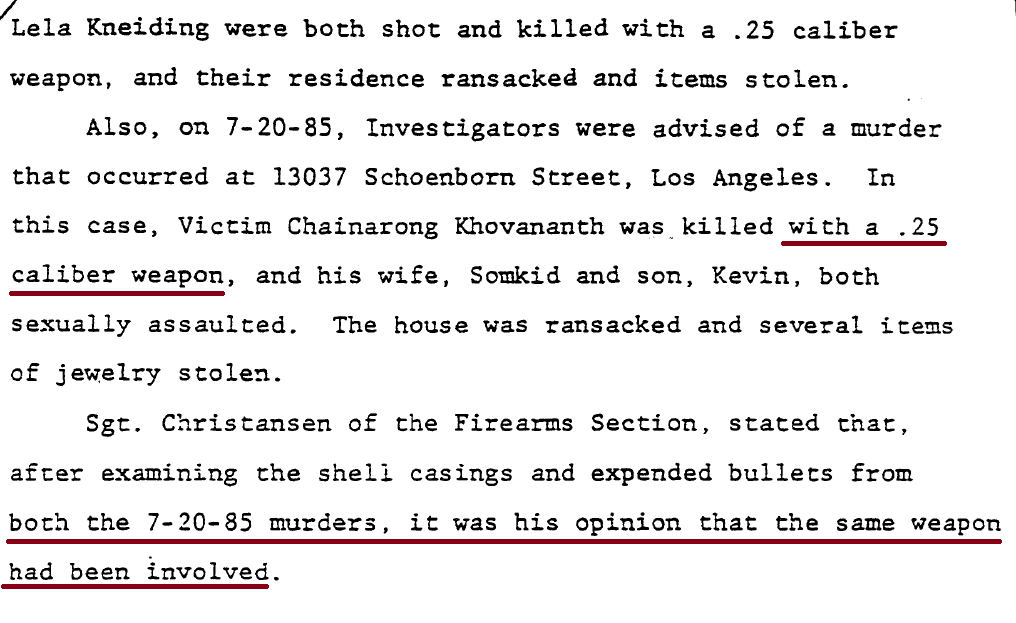July 20, 1985
This post is part of a series analyzing the prosecution of Richard Ramírez, known as the “Night Stalker.” We examine each case attributed to him to assess whether the evidence truly supported his conviction using his 2008 Federal Petition for Writ of Habeas Corpus and its supporting documents.
****This post contains details of sexual assault and crime scene information. Reader discretion is advised. ****
Per Somkid Khovananth’s report to the police, she woke up at 12:30 a.m. to let her husband in, as he had just gotten home from work. He went to bed, and she stayed in the living room. She locked the front door. A sliding glass door from the living room to the backyard was kept open. Sometime after this, she was awakened by the opening of the sliding glass door. She saw a tall, skinny man with a gun, who told her to be quiet and threatened to kill her.
He went to the bedroom, shot her husband, Chainarong Khovananth, at close range and then beat and raped her. She reported her attacker then took her into the bathroom, tied her hands with a portable hair dryer cord, led her back into the bedroom, beat her again, and forced her to engage in oral copulation and anal sex.
Around this time, the alarm clock went off in her son’s room, indicating it was 6 a.m.; it was now daylight outside. The assailant went to her son’s bedroom multiple times, first to demand jewelry, second to sexually assault him and the third time to beat him up. 15 minutes later, the attacker began looking for jewelry and money. She told him there was jewelry in a kitchen drawer, gave him $80 cash, and a silver coin collection.
Somkid said her assailant took her into her son’s room; she saw he had been tied up, his pajama bottoms were torn off, and a sock was shoved in his mouth. In an effort to get the assailant out of the house, she told him there was also jewelry in her husband’s car in the garage. They went to the garage and found $15 in a wallet under the front seat. When they went back inside the house, the perpetrator asked for a suitcase. He put a VCR in the suitcase, put the jewelry into a pillowcase, and put the pillowcase into the suitcase. Somkid stated he then bound her again, leaving her on the master bedroom floor, slapped her, and left. LAPD arrived at the Khovananth residence at 7 a.m.
Physical evidence:
- Small caliber bullet recovered from Chainarong’s skull.
- Ransacked house, food on floor.
- Butcher knife and apple juice in son’s bedroom placed by the killer.
- Avia shoeprints.
Below: the knife in the son’s bedroom.

The butcher knife
Identification
Although we do not have Somkid’s police report, we have detailed information concerning the Khovnanth incident in the 2008 Federal Petition for Writ of Habeas Corpus, including Somkid’s original description of her attacker and statements she made shortly after the crimes and in court. Below is an LAPD press release detailing the crime from Habeas document 20.3. Her police statements are not yet available.

Chainarong Khovananth’s sister Debbie spoke with Somkid Khovananth the day after her brother’s murder. Somkid told Debbie that her attacker had “curly hair and dark skin.” He had an accent that she could not identify and spoke in an “uneducated” manner. She stated he wore gloves that were gray or light brown cloth (Habeas Corpus Document 14, p. 87).
Preliminary hearing documents reveal that she originally said the killer had light brown hair. Somkid made numerous excuses for this discrepancy under cross-examination.

The Khovananth Composite
After the incident and before the live line-up, Somkid met with police three to four times. She helped create a composite sketch that became the most prominent of the Night Stalker case, in which she described her assailant as having “stained, gapped teeth.”

The Los Angeles County Sheriff’s Department had already set their sights on a mysterious suspect with bad teeth. “Richard Mena,” a man who escaped a traffic stop was a person of interest. This was actually Richard Ramirez using an alias.
From this moment on, the Night Stalker, aka the Valley Intruder, would be synonymous with “bad teeth,” with the Night Stalker Task Force proclaiming that the man who attacked Somkid Khovananth was the same man seen by all other victims. This is explained in another article.
However, this is untrue: no other alleged Night Stalker victim said anything distinctive about their assailants’ teeth. Nor did they all say he was tall with dark curly hair. A state of panic ensued throughout the Los Angeles area.
During her in court cross-examination, Somkid Khovananth acknowledged that she initially described her assailant as a having a darker skintone.
“On cross-examination, Ms. Khovananth acknowledged that she had previously described her assailant as having a brown face like a Mexican.”
– Document 14, Federal Petition for Writ of Habeas Corpus
The Prosecution’s Evidence
The prosecution linked seven Night Stalker crimes with alleged Avia Aerobics model shoeprints. These were Zazzara (a shooting and multilation case), Doi (male shot, woman assaulted), Bell and Lang (bludgeoned and tortured), Cannon (bludgeoned, stabbed and strangled), Bennett (bludgeoned and strangled), Nelson (bludgeoned and strangled) and Khovananth.
Detectives found shoeprints on the Khovananth’s front porch, back doorstep, and hallway. Lifting tape was used to collect the print from the porch. Los Angeles County Sheriff’s Department criminalist Gerald Burke examined it and concluded the impression was made by an Avia Aerobics shoe, size 11-½ to 12. Below is an image of the shoeprint:

The shoe print on the front porch
Prosecution firearms examiner, Edward Robinson, testified that the bullet found in Chainarong Khovananth’s head matched those from the Zazzara scene. They allegedly came from a .22 revolver. This made two circumstantial connections with Zazzara, which occurred four months earlier and was 33 miles away from the Khovananth home.
Property recovered from the ‘fence’ Felipe Solano and identified by Somkid circumstantially linked the Khovananth crime to Richard. Solano claimed that Ramirez sold him the stolen items.
The prosecution urged conviction based on similarities to the Abowath case (Aug 8th) where the husband, Elyas, was killed and the wife, Sakina, was robbed and raped at gunpoint. The Abowaths’ property was also allegedly found with Solano, circumstantially linking the two cases.
Rebutting the Prosecution’s Evidence
Identification:
Somkid Khovananth’s description of her attacker was inconsistent, varying from a white individual to a dark-skinned individual. Chainarong Khovananth’s sister, Debbie Piyaratanaphipat, testified for the defense that Somkid told her that the man had a “brown face.” (Habeas Corpus pg. 87) Somkid denied this. (Philip Carlo. pg. 316).
Somkid Khovananth identified Ramirez at the live lineup on September 5, 1985. But sheriff’s deputies were caught influencing witnesses to choose suspect 2 – Richard Ramirez. This can be seen in the video below.
She also stated she saw Richard’s picture on television and in the newspapers constantly before and after his arrest. This meant that her identification was potentially influenced by the media as well as cops.
Interestingly she did not call the police to inform them that the Night Stalker was her attacker. This was the case with other Night Stalker victims, Carol Kyle, Sophie Dickman and Virginia Petersen. (Declaration of Dr. Kathy Pezdek, expert psychologist for Ramirez’s appeals document 16.7).

Ballistics:
According to Paul Dougherty, writing for Ramirez’s appeals, the ballistics needed retesting because the original firearms examiner disagreed with the findings of the expert who testified at trial – as mentioned, Robinson said Chainarong was killed with the same .22 revolver used in the Zazzara attack.
But according to the affidavit, LASD Sergeant Robert Christansen originally assessed the Khovananth bullets to have come from a .25 caliber automatic pistol. (Affidavit, document 7.4 pictured below). This meant that the guns were originally linked to the Kneiding, Petersen, Abowath, Pan and Carns attacks.

The firearms used in the Night Stalker attacks were never found; no legitimate ballistics testing was ever conducted comparing the guns to the slugs and casings. So it is impossible for Robinson to truly know that the Khovananth bullets matched those at Zazzara.
Despite discrepancies in the firearms examiners’ reports, the defense neglected to challenge the bullet distortions and firearm identifications. They even conceded the prosecution evidence.
“With respect to ballistics evidence, trial counsel offered no evidence, instead stating: “[Y]ou have to assume that the [prosecution’s] ballistics evidence is correct.” Counsel unreasonably conceded evidence that the prosecution used to link Petitioner to other incidents.”
– Habeas Corpus, pg. 418.
Shoe prints:
Criminalist Burke lacked the necessary experience and training to effectively compare shoeprint impressions. The casting impressions were distorted, and measurements were obtained incorrectly, leading to critical inaccuracies. The lifts made from the shoeprint on the front porch were missing the crucial heel area of the shoe, making it impossible to accurately determine the exact model and size.
Similarly, the prints near the back step and hallway were partial prints and inadequate for determining a shoe model or size. Furthermore, no Avia shoes were found on or in Richard’s possession, and his shoe size was never determined at any point. (Shoe forensics expert, Lisa DiMeo, Documents 7.19 and 7.20).
Despite this, the defense conceded the prosecution’s shoeprint evidence, missing a significant opportunity to present reasonable doubt by not seeking a forensic shoeprint specialist to examine the evidence. Consequently, the jury never heard that the shoe print evidence was insufficient to identify the exact model of the shoe and that thousands of shoes could have left the same impression. See this video for more information.
Solano’s Involvement:
The Khovananth attack was linked to the Doi, Bell & Lang, Kyle, Cannon, Dickman, Nelson, Kneiding and Abowath attacks via stolen property that was recovered from known ‘fence’ Felipe Solano. Solano was exposed to be a liar in possession of thousands of dollars’ worth of stolen property who was granted immunity from prosecution. He claimed Richard gave him all the stolen items but other names were revealed at trial. There are explanations for why he may have said this: Sandra Hotchkiss, with whom Richard committed burglaries, said Solano was beaten up by police. He might have been coerced to say Richard gave him everything; Richard may have been a runner of stolen goods.
The defense sought to sanction the prosecution but the judge rejected their motion. Impeaching Solano would have collapsed the case. The defense were ultimately too incompetent to impeach him adequately.
Transferable Evidence
The prosecution’s theory of events was that on July 20, 1985, Richard Ramírez stabbed the Kneiding’s with a knife and then shot them with a .22 caliber gun. He left the Kneiding’s on Stanley Avenue in Glendale and, “within minutes,” was at the Khovananth residence, on Schoenborn Street in Sun Valley, in the San Fernando Valley area of Los Angeles, 14.6 miles away.

*The 14.6-mile route from the Kneiding residence in Glendale to the Khovananth home in Sun Valley.
Did Somkid describe her assailant as having any scratches or wounds? Did he have any blood on him or on his clothes? Somkid Khovananth did not report any such thing – and her description was the most detailed of all the victims. Given she noticed several specific details about his appearance, it’s doubtful that she wouldn’t have noticed if her attacker had blood or scratches on him. It’s also extremely difficult to believe that if Somkid’s attacker was the same individual who killed the Kneidings, he wouldn’t have arrived at the Khovananth residence a bloody mess!
The Kneiding crimes were brutal attacks that left an incredible amount of forensic evidence and blood spatter on the walls, carpets, mattress, and curtains. Lela Kneiding was shot twice at close range, so her blood and bodily tissues would have ended up on the perpetrator’s clothes, shoes, skin, and hair. It would have been virtually impossible not to bring any blood or trace evidence from the Kneiding crime scene to the Khovananths.
According to the prosecution’s statement, Richard made the 15-mile drive to the Khovananth residence “within minutes” after killing the Kneidings.
“within minutes virtually of the murder of Maxon and Lela Kneiding, the defendant arrived in Sun Valley [Khovananth] … again the same morning.”
– prosecutor Philip Halpin quoted in the habeas corpus, pg. 459.
So, he would not have had time to wash up or change clothes. He would have arrived at the Khovananths saturated with blood and biological evidence from the Kneiding crimes and the evidence would have also been in his vehicle. Had forensic evidence from the Kneiding crime been in his vehicle or at the Khovananth property, the prosecution would have undoubtedly used this evidence against him.
Epic Failure
The prosecution’s case against Richard Ramírez in the murder of Chainarong Khovananth and the sexual assault of Somkid Khovananth was not proven beyond a reasonable doubt. The lack of physical evidence against him strongly indicates that Richard’s conviction resulted from the failure of his inept defense to adequately counter the charges against him. The defense attorneys, by neglecting to vigorously challenge and refute the prosecution’s case on numerous crucial points, ultimately facilitated Richard’s wrongful conviction.
It’s important to note that we do not discount or minimize the suffering of the victims and their families. These crimes were devastating tragedies, and those responsible should have been brought to justice. Unfortunately, that did not occur. Instead, a young man with serious physical and mental health issues, limited means, and financial support was wrongfully convicted for crimes that were never proven beyond a reasonable doubt.
Source: 2008 Federal Petition for Writ of Habeas Corpus, Richard Ramírez vs. Robert Ayers.
KayCee

Leave a comment